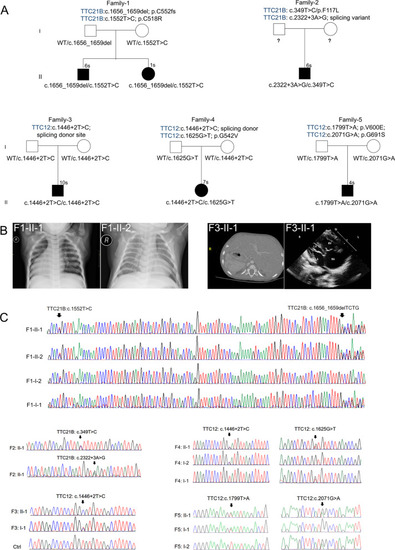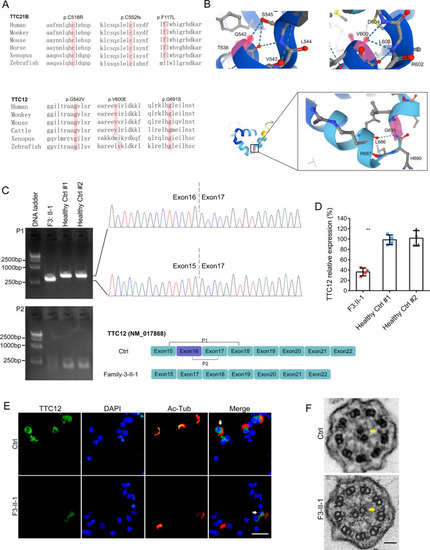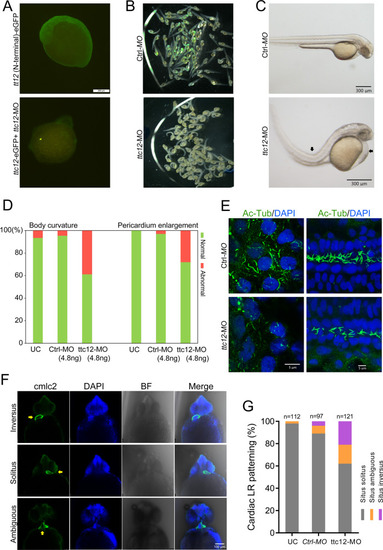- Title
-
Biallelic mutations of TTC12 and TTC21B were identified in Chinese patients with multisystem ciliopathy syndromes
- Authors
- Chen, W., Wang, F., Zeng, W., Zhang, X., Shen, L., Zhang, Y., Zhou, X.
- Source
- Full text @ Hum. Genomics
|
Biallelic TTC21B and TTC12 mutations in five unrelated family trios with multisystem ciliopathy syndromes. A Pedigrees of families (F) 1?5 indicating the affected individuals and the segregation of TTC12 or TTC21B heterozygous variants. B Representative images of the clinical diagnosis of affected individuals (F1-II-1, F1-II-2, F3-II-1) using chest X-ray imaging, CT scans, or color ultrasound scans as indicated. A mirror-image arrangement of the abdomen is shown in F1-II-1 and F3-II-1. Color-Doppler at the parasternal long axis view showing the parallel relationship of the great arteries and ventriculo?arterial discordance with DORV, ASD and PS in F3-II-1 (right panel). C Sanger sequencing of recessive TTC12 and TTC21B variants in six affected individuals and their unaffected parents in five family trios with ciliopathy syndromes. Parent samples were not available for segregation analysis in Family 2 |
|
TTC12 c.1446 + 2 T > C causes exon skipping and downregulates its expression, which further leads to ultrastructural defects in IDA. A Sequence alignment of TTC21B and TTC12 variants in different species, including zebrafish (Danio rerio) and tropical clawed frogs (Xenopus tropicalis). B AlphaFold protein structure prediction showing the potential effects of amino acid substitutions (G542 V, V600E, and G691S) on hydrogen bonds that might exert a direct influence on the protein structure of TTC12. C TTC12 exon 16 was entirely skipped in the patient (F3-II-1) carrying c.1446 + 2 T > C of TTC12 (NM_017868) by cDNA amplification followed by gel extraction and Sanger sequencing. cDNA derived from fresh nasal samples of this patient and two healthy volunteers was amplified. Representative images from three independent experiments are displayed. D mRNA levels of TTC12 were downregulated in the patient carrying c.1446 + 2 T > C by real-time quantitative PCR. **p value < 0.01, (two-tailed Student?s t test; n = 4). E Immunofluorescence staining with anti-TTC12 antibody showed the decreased signal intensity of TTC12 in the cytoplasm of cells derived from the patients (F3-II-1) when compared with healthy controls (Ctrl). Scale bar, 10 Ám. F Representative images of transmission electron micrographs (TEM) of cross sections of ciliary axonemes from the patients (F3-II-1) and a healthy control (Ctrl). Distal absence of IDA is indicated by the yellow arrow. Scale bar, 50 nm |
|
TTC12 knockdown causes defective LR patterning in zebrafish embryos. A Efficiency of ttc12-MO is evaluated by simultaneous coinjection of ttc12 (N-terminal)-eGFP mRNA that effectively abrogates GFP signals in embryos at 16 hpf. Scale bar, 250 ?m. B An overview of the morphology of zebrafish embryos injected with Ctrl-MO or ttc12-MO. C A representative image of body curvature and pericardium enlargement in ttc12-MO-treated embryos is shown. Scale bar, 300 ?m. D Percentage of body curvature and pericardium enlargement in ttc12-MO- or Ctrl-MO-treated embryos as indicated. E A mild reduction in cilia density was identified in the tail fin (right panels) and pronephros (left panels) of ttc12-MO-treated embryos compared with Ctrls. A representative image is shown. Scale bar, 5 ?m. F Representative images of whole-mount immunofluorescence showing inversus, solitus or ambiguous situs in zebrafish embryos by staining cardiac myosin light chain-2 (cmlc2) antibody and DAPI using a confocal microscope at 48 h postfertilization. Scale bar, 100 ?m. G Percentage of embryos with situs solitus, situs ambiguous, and situs inversus in the uninjected control (UC) and embryos injected with ttc12-MO or Ctrl-MO |



